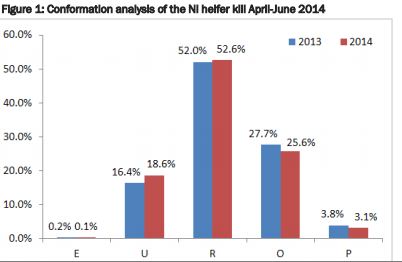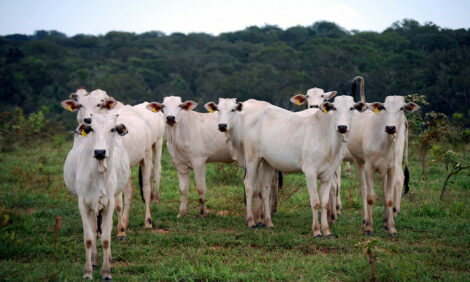



Improved Confirmation Could Come From Genetics Progress
UK - An improvement in prime cattle conformation has been noted in the second quarter of 2014 which analysts are attributing to genetic progress.When compared to the corresponding quarter in 2013, 23.3 per cent of steers achieved a U grade compared to 20 per cent last year, according to a study done by the Livestock and Meat Commission (LMC) Northern Ireland.
LMC analysts said: "It is worth noting at this point that the proportion of price reported prime cattle sourced from the suckler herd increased slightly between the two periods in question and this may have had a positive influence on conformation scores due to improved genetics."
The proportion of steer carcases achieving an R grade accounted for 38.6 per cent of the steer kill in the 2014 period, a slight decrease from the previous year figure of 39.4 per cent, added the LMC.
Meanwhile the proportion of steers achieving O and P grades accounted for 37.7 per cent of steers in the 2014 period, a decrease of 2.7 percentage points from the corresponding period in 2013.
This general improvement in the conformation of the steer kill between the two periods can be partly attributed to the slight increase in the proportion of steers sourced from the suckler herd but improved production conditions on NI farms between the two years will also have had a key influence
The steers killed in the second quarter of 2013 would have been at grass during the poor summer of 2012 and this would have had a negative effect on animal performance with cattle housed at lower than expected liveweights.
.
Graph courtesy of the LMC
The effects of the wet summer of 2012 also resulted in reduced quality and availability of forage for beef finishers which will have further impacted animal performance during housing and thus final carcase weights in 2013.
Recent studies from AFBI have indicated a link between carcase weight and conformation score so with these cattle finishing at lower carcase weights as a consequence of production issues the conformation scores will also have been negatively affected.
The average price reported steer carcase weight in the second quarter of 2014 was 351kg, an increase of 5kg from the 346kg recorded during the same period in 2013.
Although the delayed spring in 2013 will have reduced grass growth in the early grazing season when the good weather did arrive it boosted grass growth, improved animal performance and allowed many beef producers to extend their grazing season.
Many beef cattle will have entered the sheds in Autumn 2013 in much better condition than the previous year and will also have benefitted from an improvement in the quality of the forage. The combination of these factors will have had a positive effect on both carcase weights and conformation scores of the steers slaughtered in the 2014 period.
The conformation results for heifers slaughtered in the second quarter of 2013 and 2014 followed a similar trend to the steers with the results outlined in Figure 1.
As indicated in the chart there was a general improvement in the conformation scores between the two periods with the proportion of U grading carcases increasing by 2.2 percentage points to account for 18.6 per cent of the heifer kill in the 2014 period and the proportion of R grading carcases increasing by 0.6 percentage points to account for 52.6 per cent of the heifer kill.
Meanwhile the proportion of heifers awarded O and P grades decreased from 31.5 per cent in the 2013 period to 28.7 per cent in the 2014 period.
The average carcase weight of price reported heifers during the 2014 period was 312kg, an increase of 6kg from the 2013 period when the average carcase weight was 306kg. There was also a general improvement recorded in the conformation scores of the price reported young bull kill between the 2013 and 2014 periods.
It is worth noting that there was no change in the proportion of young bulls sourced from the dairy and suckler herds year on year with approximately 50 per cent coming from each sector in both time periods.
In the 2014 period 22.4 of the young bull kill achieved a U grade compared to 19 per cent in the 2013 period while the proportion awarded an R grade was relatively unchanged at 25.3 per cent.
Meanwhile the proportion of the young bull kill achieving O and P grades decreased from 53.9 per cent in the 2013 period to 50.6 per cent in the 2014 period. Dairy origin young bulls had an average carcase weight of 264kg in the 2014 period, unchanged from the corresponding period in 2013.
Meanwhile the average carcase weight of young bulls sourcedfrom the suckler herd was also unchanged year on year at 360kg.
TheCattleSite News Desk



